|
Among all the colors, certainly red is the more important, more particular, more intense and full of meanings. It is traditionally the color of passion, of fire, of love, of feeling but also of suffering. A color that doesn't pass unnoticed, able to put in evidence. For these and other reasons the red color has also been selected as pigment of the true Italian sporting cars, winner against everyone and everything, those of which, seeing their triumphs under the chess flag, you wonder if under the bonnet there is a real beating heart. And also this, of course, red coloured. This color is often associated to the mythical cars of MARANELLO, defined FERRARI-RED, but it is necessary to remember that in past other cars, not only in Formula 1, have written the history wearing a red suit. The ALFA ROMEO and the MASERATI, for instance, but also the sporting LANCIA cars as the STRATOS and the FULVIA or the "bad" FIAT as the 131 ABARTH. All of them rigorously red, almost as if there were painted on the car body a sort of Italian flag, not tricolor but clearly monochrome. And it was with this beautiful fire-red suit that, on 21st April 1982, the LANCIA RALLY 037 was introduced to the public. The occasion was important indeed. The 59th Turin International Motorshow represented one of the most important kermesse in the world and the fact that it was held in Italy made even more winning such debut. A jewel of the Italian technology ready to receive a heavy inheritance, the one of the FIAT 131 ABARTH, last World Rally Champion, and of its sister LANCIA STRATOS, practically so unbeatable to be defined "bete à gagner" from the transalpine cousins and usual rivals.
The party atmosphere that fluttered along the pavillons and the intense reflectors lights were so able to put even more in evidence the red aggressive lines, than it was practically impossible not to fall in love with this made in Italy creature. The 037 was not by chance been unanimously chosen "queen" of the EXPO getting, still before to race, an important recognition: that of the critics.
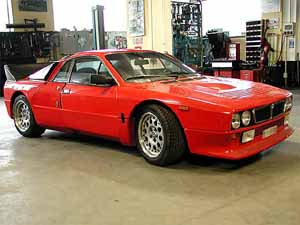 |
PHOTO.1 |
PHOTO.2 |
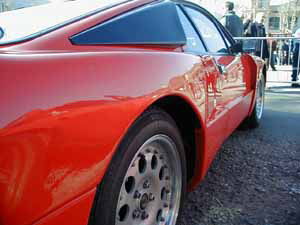 |
So, we analyze this car starting from the frame structure to go then to discover all that small details that only the careful eye of the expert is able to note and that make the 037 a car unique in the world. Observing the car, we notice a certain similarity with the LANCIA BETA MONTECARLO, car from which it uses the central frame, but with completely different aerodynamic lines and track. Frontally, the 037 distinguishes for the flat and protruding spoiler with two horizontal air intakes for the oil and the water radiators. The grille is the classical LANCIA one, on purpose designed for this model. In the center we find the well known mark of the Italian Company and, at the sides, they find place the double light groups, headlights, anti-dazzle lights and fog lights, these last ones of rectangular shape. The wide front bonnet is in fibreglass with a light central swelling to consent the lodging of a small spare wheel in the below part, while in the upper part there are three air intakes for the cockpit ventilation. This is harmoniously joined with the anterior windscreen, endowed with two adjustable two-speed plus stop-start facility windshield wipers. The roof has two parallel bulges, feature already adopted in past on the ABARTH ZAGATO and necessary to give extra headroom to the crew. The top is fixed to the chassis with three rivets set at the rear and from two flat-head screws at the front. The rear bonnet is fastened to the roof and is characterized by the sweeping rear window that allows a complete view of the engine. This last one is sheltered by two special protections against the mud and the dust that are normally raised by the rear wheels. In the terminal part we find the lodging for the toothed spoiler, optional on the road version but default on the competition one. On the sides, we find two dinamic air intakes on purpose built to ventilate the engine. On the back, the LANCIA 037 distinguishes for the two big rectangular light clusters and for the air outlet grilles with, in the center, the plate site, positioned among the rear fog lights. The dimensions of this masterpiece are 3915 cms length, 1850 cms width, 1190 cms height, 2440 cms wheelbase and 1508 cms track.
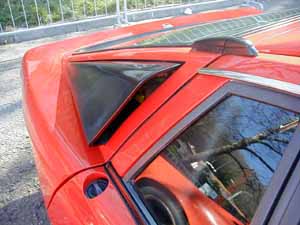 |
PHOTO.3 |
PHOTO.4 |
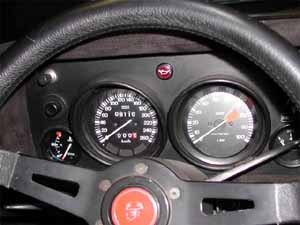 |
Observing the inside car, we can note as everything is rational and finalized to a sporting use. The feeling, once sat on the comforting black velvet height and depth adjustable seats, is that to be inside a true rally-car. Everything is at the correct place and all the instrumentations are essential, apparently simple but realized with particular care. The instrument dashboard is in fibreglass and the front is in an oxalised black light alloy. The dashboard is coated with neoprene, a soft touch material normally used in the construction of the wetsuits. In the right side there is a lock-up documents drawer, while to the left we find the whole instrumentation essential for a classic sports car. Here are therefore the oil temperature and pressure gauges, the water temperature gauge, the turbocharging pressure gauge, the electronic speedometer with trip counter and reset button, the fuel gauge and the frontal and rear foglight and the handbrake indicators. A reostat finally make possible to regulate the intensity of the instruments illumination. The central console contains the ashtray and, in evidence, two series of easily accessible automatic heatproof fuses. In fact, in case of tension overload, it isn't necessary to replace them, but it is enough to switch them on again pushing a simple button (one per fuse). This lodging also includes a quartz clock, the air-conditioning controls and, on the co-driver side, a courtesy light with extensible cable. The three-spoke sports leather-coated steering wheel, adjustable in height, has, well evident in the center, the ABARTH logo. Under this they find place three stalks controlling lights, indicators windscreen wipers. Between the two seats, finally, in the prolongation of the central part, there is the handbrake lever, the electric window controls and the gear lever, the leather base of which bore the ABARTH and PININFARINA logos. Pedals were very carefully designed. The brake, clutch and accelerator pedals are in light alloy and they have a big dimension in comparison with the traditional one, to allow a decidedly sporting drive, generally used by the experienced rally drivers. Behind the seats, finally, practically inside the cockpit, there is the engine compartment, separated by a double-glazed window and by a sound-absorbing panel. Despite these two shrewdness, the noisiness inside the cockpit is decidedly high.
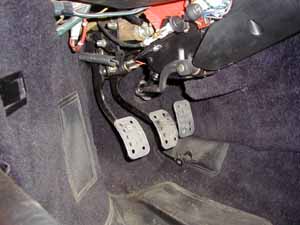 |
PHOTO.5 |
PHOTO.6 |
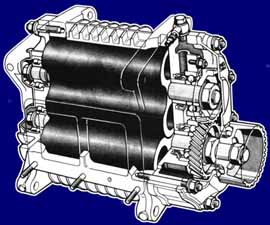 |
The cockpit, driver survival frame, is protected from a strong roll-bar made by circular section pipes with diameter of 35 mms, as prescribed by the FISA safety rules. The front cage frame serves to anchor suspensions and water and oil radiators, the rear cage for the suspension mountings and those of the two fuel tanks and for the whole engine unit. This system is made of tubular steel pipes of small dimension, only 25-30 mms diameter, but of elevated sturdiness and rigidity that allows to the car to withstand very high. The strong points of the LANCIA 037 are however represented by the set-up and by the gearbox-engine group in rear-central position, practically behind the driver and inside the cockpit. The engine is a FIAT classic, a four cylinder in line with cast iron cranckcase and light alloy head with 84 mms bore and 90 mms stroke cylinders . The distribution is controlled by a toothed belt that transmits the movement to the twin overhead camshafts, each one made in forged steel and lodged on five bench supports. The valves are four for each cylinder and they respectively have a diameter of 34,5 mms for the intake and 28 mms for the exhaust. The platformed combustion chambers has specially moulded pistons. The valves for this kind of configuration are asymmetrical and have a different inclination in comparison with the central cylinder axle: 24° for the intake ones and 22° for the exhaust ones. The valves tappet cover, under which we find these parts, is in aluminum alloy and, in the center, we find the prestigious ABARTH logo.
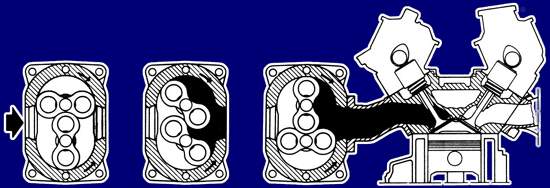 |
PHOTO.7 |
The described system is the same carried out for the winning FIAT 131 ABARTH but the LANCIA technicians, because of power demand, added a mechanism of overfeeding through a ROOTS volumetric compressor. Such compressor, also defined VOLUMEX, is a technical detail directly coming from the race engines. Some track cars, in fact, as the ABARTH 035-LE MANS and the BETA MONTECARLO-GIRO D'ITALIA used this kind of overfeeding, able to confer a sudden reply even at low speed and a very high torque, so much necessary both in track and in the tortuous rally roads. The advantage offered by this solution is the possibility to compress the fuel mixed to the air through a lobes system and to increase its power in the combustion phase. The fuel is lodged in two side fuel tanks of aeronautical conception, each one of 35 liters ability and sent to the WEBER DCVNH15/250 twin-choke carburettor, through a low pressure electric pump. Furthermore the carburettor is endowed with partialization butterflies valves of 40 mms of fluid diameter and, being before of the volumetric compressor, it doesn't need the POP-OFF safety valve, instead present on the more powerful race version.
The exhaust system is composed by four specially moulded manifolds, one for cylinder. These manifolds unite in two parallel pipes that meet inside the voluminous silencer to undouble again up to the chromed outlet pipe, situated on the rear right side of the car.
Engine lubrication is dry oil sump, as for the most part of the race cars. The circulation system is composed by three pumps, one of delivery and two of return, positioned in the inferior part of the cranckcase. The oil is practically always in circulation and when it reverts in the small cup in light alloy, situated on the inferior part of the engine, it is sucked in the two parallel pumps and sent in a cylindrical tank on the engine right side, near to the manifold exhausts. The delivery pump sucks the oil necessary to the lubrication, conducts it through the filter group and then the oil reaches the cooling system, situated in the anterior part of the car, and returns inside the engine to lubricate the movements parts. The pressure of the circuit is always constant and the value is attested around the 4/4.5 bars, while the system ability is about 8 liters.
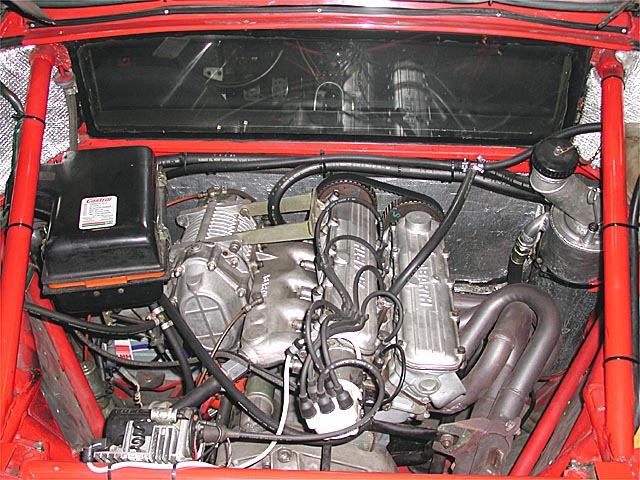 |
PHOTO.8 |
PHOTO.9 |
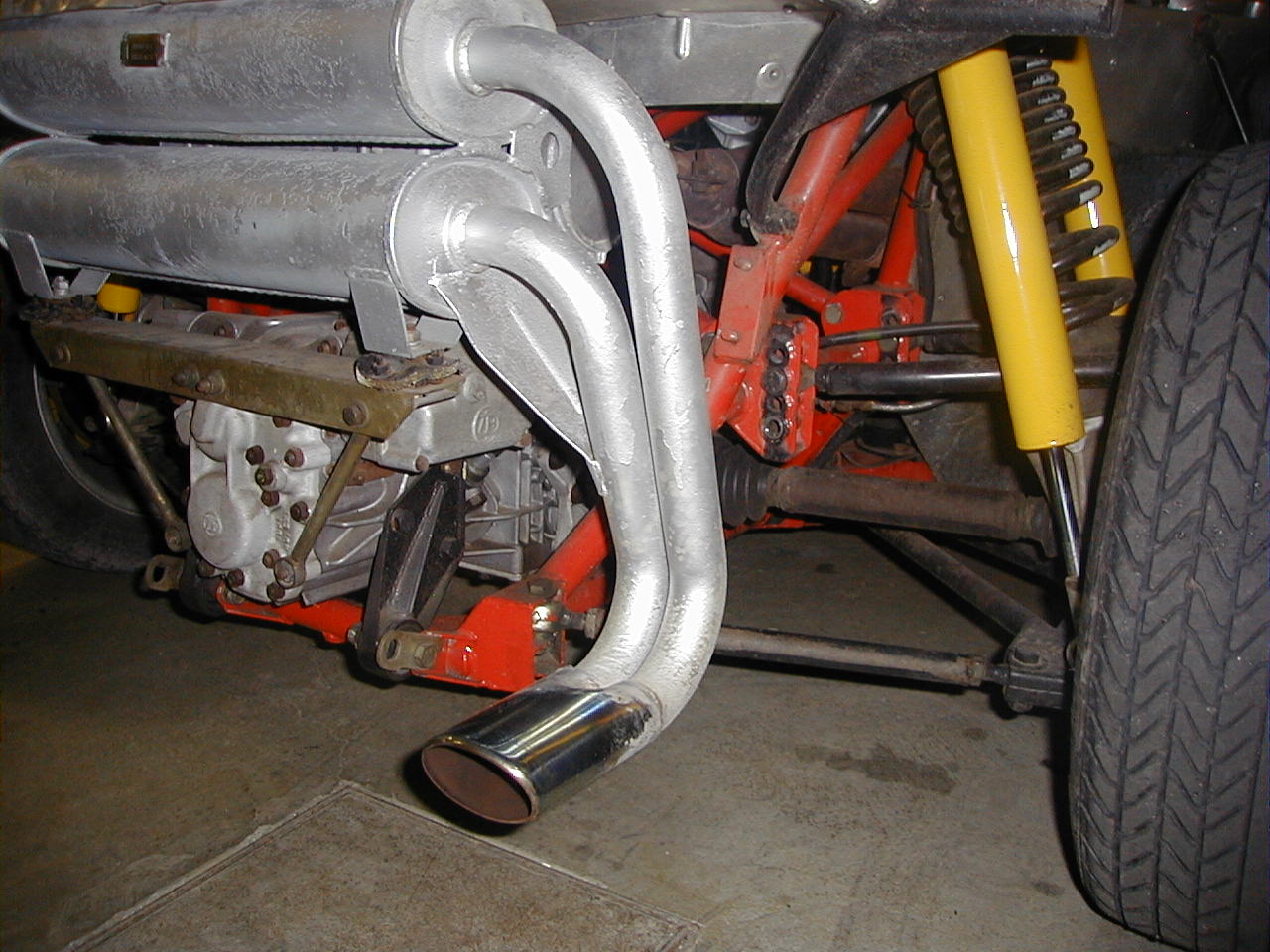 |
The water cooling system is made up of a radiator, anteriorly positioned near the oil one and endowed with elettrically driven-fan, supplementary tank and circulation pump. The ability of the circuit is about 9 liters.
The MARELLI AEI 200 breakerless electronic ignition has inductive discharge and foresees the use of four CHAMPION N2G sparking plugs. The flywheel is imprinted with a special setting mark visible through a slot on the clutch cover. This whole system confers to the LANCIA 037 good performances with maximum power of about 205 Bhp to 7000 rpm and 23.5 Kg/ms of torque that give a specific power of 102.5 Bhp/litre.
If the engine is very important for a sporting car, also it is the gearbox. For the LANCIA 037, the ABARTH technicians adopted a ZF manufacture system, lodged behind the engine, jutting out at the rear part of the car and five-speed plus reverse. The gear arrangement is not the classical one, but the reverse is up leftwards while the first gear down leftwards. The choice to adopt this particular kind of gearbox, although considered of bulky dimensions, was dictated by the urgent need. There were a lot of hurry in the building of the 200 units destined to the group B homologation and the ZF gearbox was at that moment the only available as well as the surer and more reliable because already mounted on sporting cars as the MASERATI BORA and the DE TOMASO PANTERA. The 25% self-locking differential was mated to the transmission. The drive was transmitted to the wheels through axle shafts fitted with constant-velocity joints at their ends. The 037 speeds are excellently distributed and they allow to reach at 7000 rpm the speed of 140 Km/h in third gear, 190 Km/h in fourth gear and 228 Km/h in fifth.
A speed of great respect for a sporting car of that epoch, that requested a safe and dependable braking system. To such purpose, on the LANCIA 037 they find place four powerful self-ventilating brake discs, supported by a double circuit with front and rear vacuum servos controlled by the tandem pump. The aluminium calipers, made by BREMBO, derive from the experience made in the track races of the FIAT ABARTH single-seater in the early-80s, able to tolerate stress situations without particular fatigue signs. The unit also comprises a brake effort proportioning valve, especially useful at prolonged high speeds. Each mechanic particular built for the safety of the crew has been realized with the maximum care. As for the braking system, also for the steering unit the choice was governed by efficiency and safety considerations. A rack and pinion system was thus chosen, with an articulated height-adjustable steering column. The latter, composed of four elements, is releasable and allows to the steering box to spring back in case of collisions, protecting the driver from frontal impacts against the steering wheel.
The most remarkable breakthrough, from a mechanical point of view, is certainly represented by the suspensions. They had an independent wheel parallelogram layout, with trailing arms resting on uniball articulated metal joints, the lower arms longer than the higher. The gas shock-absorbers are single on the anterior part with 12 coils springs and double on the rear one with springs increased to 13 coils, these last ones mounted with the inverted stem. The height from the ground is adjustable and obtainable acting on a threaded ring that compresses and lengthens the springs according to the rotation sense. Very clever and mechanically good is the solution used for the swinging bars connection. Each inferior bar has two linkage centers that become four for the superior ones. This is translated in many possibilities of set-up change, modifying the static and dynamics geometries and allowing in a short time to optimize it, according to the road surface or simply to the personal drive style of the driver. Besides this allows to get extensive degrees of travel of the suspensions from 190 mms up to 260 mms without never jeopardizing the traction and the roadability. This last is excellently supported by the PIRELLI P7 tires 205/55 VR 15 on the frontal part and 225/50 VR 15 on the rear one, assembled on dismountable wheel rims with central aluminum alloy hub and molded plate rim with the LANCIA logo.
Soft but aggressive lines, light but strong chassis, elastic but "bad" engine, powerful and modular brakes, changing set-up, excellent roadability and indeed sporting performances. This is the look of the "Woman in Red", still able, in the third millennium, to fascinate thousand of fans. In the following years the tradition of the italian sporting cars continued and, today, it is still a symbol and a myth. The LANCIA DELTA S4 was red, as the DELTA INTEGRALE, last car that defended the Italian colors in the rallies. And then there are of course the FERRARI, unique cars winner of the last three Formula 1 World titles. We wish ourselves, as sporting and impassioned men, that, once ended the cycle of the track red cars, it could open a new one in the rally, with a new LANCIA red car again on the top of the world.
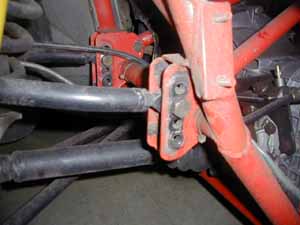 |
PHOTO.10 |
PHOTO.11 |
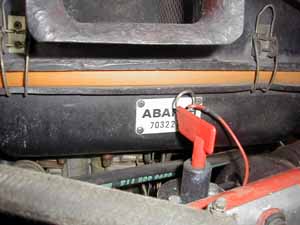 |
| .:: Pictures ::. |
|
PHOTO.1 - Particular of the side car sight. The boot spoiler is optional.
PHOTO.2 - Particular of the side car profile.
PHOTO.3 - Particular of the car back side with the engine cooling air intake. It is possible to see also the fuel tank plug and the steel hinge for the bulky rear bonnet.
PHOTO.4 - Particular of the dashboard, steering wheel, speedometer and revolution counter.
PHOTO.5 - Particular of the pedals. They are made in light alloy and fixed to the supports.
PHOTO.6 - Technical sketch of the ROOTS volumetric compressor in section.
PHOTO.7 - ROOTS volumetric compressor operation scheme. The air-fuel mixture goes out of the carburettor, is compressed inside the lobes and then introduced in the cylinders to an upper pressure increasing the output of the inside combustion.
PHOTO.8 - Particular of the engine. Please note the absence of the voluminous air filter and of the POP-OFF overpressure valve, instead present on the competition cars.
PHOTO.9 - Particular of the exhaust system. The four pipes unite in two, then to become one in the silencer and to again undouble up to the chromed output pipe.
PHOTO.10 - Particular of the attack of the swinging bars, adjustable in four positions. This to get different set-up regulations.
PHOTO.11 - Particular of the lever to disconnect the battery voltage in case of emergency. |
*** BACK ***
|